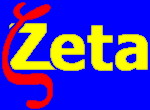
Home
Zeta on sourceforge.net
About zeta potential
libzeta / Zeta Library
Zeta for Windows
Zeta Command Line
Zeta for DOS
History
File formats
License (GNU GPL)
Author's homepage
Feedback
[ If you came to this page looking for information on Zeta Linux virtual architecture, you can click this link to get to their homepage. ]
News
libzeta 0.9.1 released
A bugfix release. Click here to download.
Zeta
Zeta can be used to calculate zeta potentials for ka > 6 from electrophoretic mobilities measured at the stationary level or from apparent zeta potentials displayed by zetameter (estimated by Smoluchowski equation). Apparent mobilities measured at 3 different levels in a rectangular electrophoretic cell (aspect ratio > 4) can be used to calculate the zeta potential (parabola method).
Zeta is free software, licensed under the terms of the GNU General Public License, which, among other things, means that the source code is available to the public. Currently, following versions of Zeta are available:
- Zeta Library - a C++ library, which you can use with your own programs, so they can perform zeta potential calculations
- Zeta Command Line - a command line program allowing you to perform Zeta'a calculations on your data (runs on most systems, including Linux and Windows)
- Zeta for Windows - a user friendly Windows interface for Zeta
- Zeta for DOS - a text-mode semigraphical user interface. This program is the oldest in the Zeta family and it doesn't use Zeta Library. It is in many aspects inferior to the other versions of Zeta.
You can visit the project's main page on sourceforge.net to take advantage of the mailing lists, the Bug Tracker etc. Most of these features are also accessible via this site. You can also find some information concerning zeta potential on the About zeta potential page.
Why do we need Zeta ?
For electrophoresis at high zeta potentials and thick double layers additional braking forces must be considered. The force exerted on the particle by the excess of counterions moving in opposite direction is called retardation. Moreover, when the particle moves fast enough the centres of the particle charge and countercharge (diffuse layer) do not coincide and thus the effective electric field strength felt by the particle is lower than the external field (relaxation). Accurate differential equations accounting for these effects have been published by O'Brien and White. These equations do not lead to accurate analytical expressions to calculate mobility from zeta potential. This problem can be solved numerically and desired accuracy can be achieved when the number of iterations is high enough. Commercial (and not open-source) programs Mobility and Winmobil are available from University of Melbourne. The solutions obtained by means of these programs are valid for any value of the zeta potential and kappa*a.
Why do we need Zeta when Mobility and Winmobil are available? For systems with kappa*a < 10 Zeta is useless. However in many systems with practical meaning 10 < kappa*a < 100 and here Zeta can help a lot (with kappa*a > 100 one can simply use Smoluchowski equation). With Mobility and Winmobil one can only calculate mobilities from zeta potentials as input data but it is mobility that can be experimentally determined. So the user has to select proper zeta potential values to cover the entire interesting range of mobilities, calculate mobilities for the selected zeta potentials and make a sort of calibration curve. The final step is to read zeta potentials corresponding to the experimentally determined mobilities from this curve (manually or by means of some computer program). With Zeta you simply introduce mobilities as input data and get zeta potentials as output data (no calibration curve is necessary). Unfortunately only for kappa*a > 10 the results will be reasonably accurate. This limit follows from the validity limit of the equation first published by Ohshima, H., Healy, T.W. & White, L.R., J.Colloid Interface Sci. 90, 17 (1982).
Many commercial zetameters have Smoluchowski equation built in the software, very often with the electric permitivity and viscosity data for water at 25 degrees Celsius so the results are displayed as (apparent) zeta potentials. When kappa*a < 100 the users of Winmobil need an additional step before reading from the calibration curve, namely they have to convert the apparent zeta potentials into mobilities. In Zeta, apparent zeta potentials calculated from Smoluchowski equation can be automatically converted into more accurate values if desired.
Last but not least, in contrast to the above mentioned programs, Zeta is free software. Not only can you download it from this page at no cost, but you also have access to the full source code. This way you know what the program you're running really does and can modify it to best suit your needs. Zeta can be compiled for many different platforms and operating systems, providing both a simple yet powerful command line interface as well as a graphical user interface for Windows. Interfaces for other systems can easily be written by other programmers using the Zeta Library.
This page is hosted by sourceforge.net
Copyright (c) 2002-2003 by
Michal Kosmulski,
last modified on
Sunday, 15 November 2009